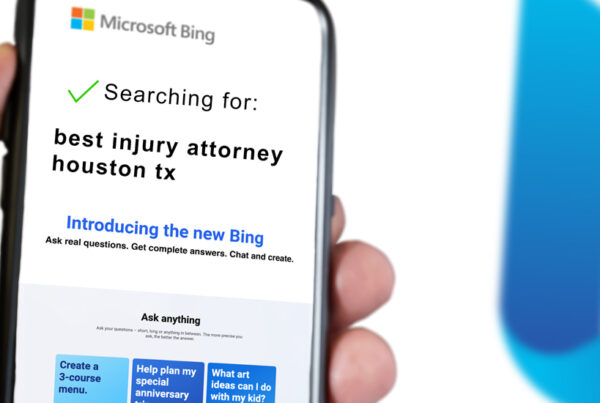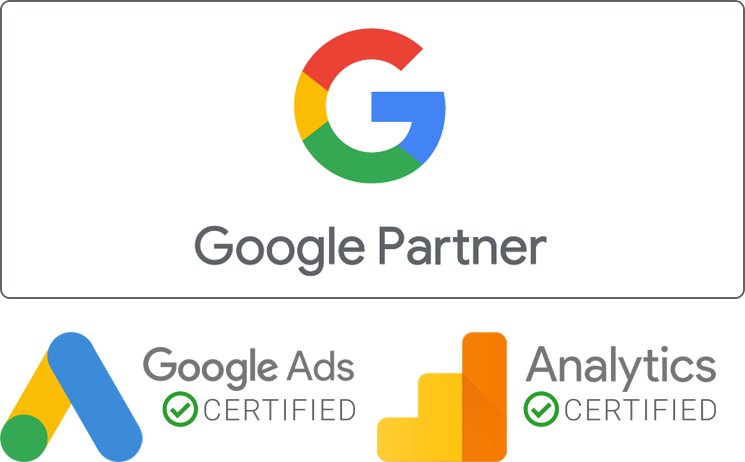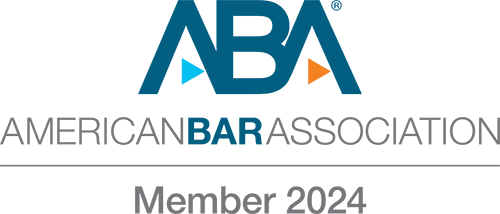Personal Injury SEO That Delivers:
More Clicks. More Clients. More Revenue.
Build your online presence into a client magnet. Our SEO services are designed to increase new client acquisition and revenue, all within a realistic budget tailored to your firm’s growth.
A successful SEO campaign is not about outspending your competition; it’s about making smarter, data-driven decisions that maximize your budget and results.
Get Found. Build Trust. Grow Your Legal Practice.

We help personal injury lawyers increase their revenue and grow their law firms through SEO strategies and services proven to work.
Guide to Search Engine Optimization (SEO) for Personal Injury Lawyers
Outsmart, don’t outspend your competitors: Secure high-value clients on autopilot with this powerful SEO strategy.
Overcome the market dominance of your competitors and larger law firms with this SEO guide tailored for personal injury lawyers. Despite what you may believe, you can absolutely compete effectively in organic search engine rankings with a reasonable and realistic budget.
When it comes to SEO, there is a long list of technical information believed in the industry to produce results. While all of this information has merit, there are actually just two key elements that will produce 80%+ of your results.
To gain and maintain a competitive advantage over your competitors, you need to learn and stay focused on these key elements. It’s not about outspending; it’s about outmaneuvering your competition.
This guide provides a blueprint for achieving higher visibility in search results for personal injury lawyers by explaining what these key elements are, and how you can make sure your SEO efforts remain focused on them. It provides personal injury attorneys and law firms with the actionable steps needed to finally start beating their competitors in online search results.
When executed correctly, the strategy covered in this guide has proven time and again to be highly effective at producing page 1 search engine rankings and generating new leads for our personal injury clients.
Let this guide empower you to either take charge of your SEO journey or collaborate with an agency with confidence, knowing precisely what you need to focus on and what you may need to spend in order to dominate the search engine rankings in your geographic service area(s).
The Value of SEO to Personal Injury Lawyers
In a recent survey, when asked “What do you find to be the most challenging parts of being an attorney?” 33% of attorneys replied with “advertising and marketing my firm.”
A successful SEO campaign can eliminate this problem almost entirely.
SEO stands out as a marketing strategy with one of the highest returns on investment for personal injury lawyers, capable of transforming your law firm’s visibility and profitability.
Let’s consider some keyword search volume. Let’s say you’re a personal injury attorney with offices just outside Detroit (not even in Detroit, just serving the areas on the outskirts), and let’s say you want to focus on motor vehicle accident cases. Here’s some real-world keyword data:
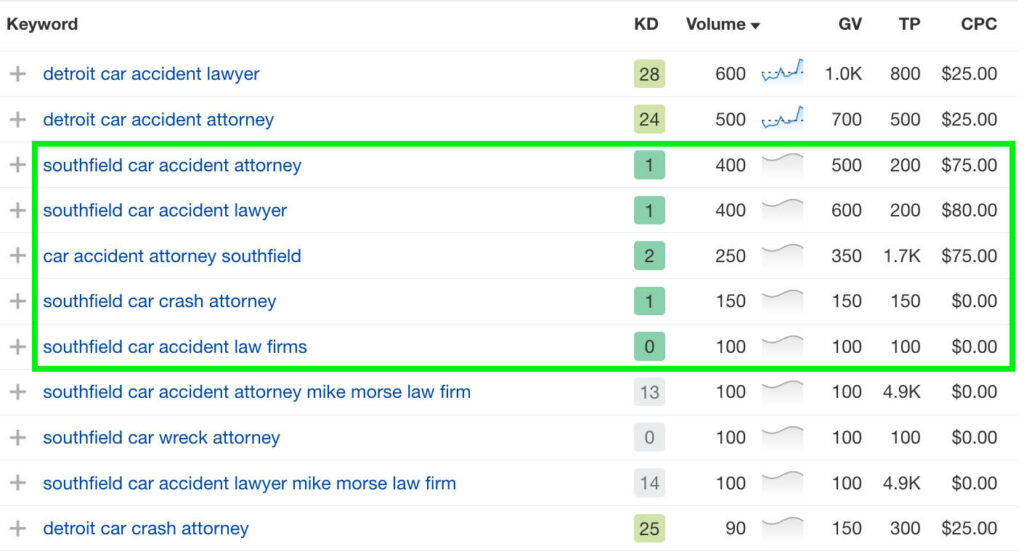
From just 5 keywords, the average monthly search volume for the keyword “car accident lawyer Southfield” (and its variations) is around 1,300 searches per month!
Now let’s say the “average” (we know this is a very relative number), but let’s use the average settlement amount of auto accidents from this case study of $25,446.84.
Imagine the transformative impact on your firm’s revenue if your SEO efforts capture even a fraction of these cases each month. The math is compelling.
And with SEO, you’re not just aiming for increased traffic; you’re strategically positioning your firm in front of individuals actively seeking a personal injury lawyer in their time of need—many of whom are likely to secure substantial settlements.
While the cost of SEO services varies dramatically, let’s say you’re paying $1,500 per month (I choose this number because I know it’s enough to realistically compete in most markets). It’s easy to see how the cost of SEO services pales in comparison to the potential returns.
When SEO is done correctly, your website becomes a powerhouse, funneling dozens of high-intent clients to your firm. This means that even one or two successfully converted leads each month would likely cover the cost of your SEO services, with each additional case significantly increasing your ROI.
The Cost of Internet Traffic: PPC vs SEO
Now let’s take a quick look at what you would have to spend on Google Ads to get the same traffic.
Going from the example above, the average cost per click for the keyword “car accident lawyer Southfield” is $80. You read that right, that’s $80 for just one click on your ad. So, the same budget for PPC ($1,500) would get you just 19 clicks per month.
So, the top-ranking website for that keyword currently is getting around $29,000 worth of traffic for around $1,500 (and that’s just ONE keyword and its variations). As SEO builds upon itself month after month, it delivers more traffic from more keyword variations (all of which would cost more individually per-click through a PPC campaign).

So Why Isn’t Every Personal Injury Lawyer Utilizing SEO?
That’s the $1,000,000 question. Truth be told, even in 2024, you’re still early to the party. It is incredible to me to see that a business opportunity with extremely lucrative potential is still not being taken advantage of by many attorneys (not just personal injury attorneys, but most attorneys in general).
From my experience it’s one of two things. They have tried it and unfortunately been burned by a bad SEO company, leaving them to believe SEO doesn’t work. Or, they haven’t tried it yet because they remain skeptical or are confused and don’t know where to start.
That is precisely the purpose of this guide.
The key is knowledge. Knowing how to ensure your SEO budget is being spent wisely with a focused and strategic approach that produces results. The rest of this guide is designed to do just that. It’s written to equip you with the knowledge needed to finally start taking advantage of the huge opportunity SEO affords personal injury attorneys who get it right.
SEO 101: Understanding the Basics – 5 Key Elements
While there are certainly many “deep in the woods” technical aspects of SEO, to have a successful SEO campaign, you really need to focus on just five key elements. These are:
-
Website Structure
-
Content Strategy
-
On-Page Optimization
-
Backlinks
-
Google Maps & Local SEO
Furthermore, around 80%+ of your SEO results will come from just two of these key elements: Content Strategy and Backlinks.
Initial efforts need to be made on setting up the on-page SEO and site structure correctly, but once these foundations are in place, it really just comes down to content and backlinks. This is where you should be focusing a majority of your resources and efforts.
The intricacies of algorithms, keyword density, and the myriad of SEO tools out there can distract from these core components. However, consistently creating valuable content and establishing a strong backlink profile are the main drivers that will propel a personal injury law firm’s website to the top of search engine results.
In this section, we’ll demystify SEO and break down these elements so you can understand and leverage them to your law firm’s benefit.
Key Element 1: Website Structure
A strategically and correctly structured website with dedicated service and location pages is critical to high search engine rankings for personal injury law firms.
Google’s algorithm has evolved to favor content that aligns closely with user queries and more specifically, a user’s intent. This means a well-organized site that clearly delineates specific services and caters to specific localities is more likely to outperform a generic homepage that is trying to cover all keywords.
For example, if someone is in a motorcycle accident, they are far more likely to search the keyword “motorcycle accident attorney near me” than they are “personal injury attorney” or “motor vehicle accident attorney.” If your website only has one page dedicated to motor vehicle accidents, you are almost certainly not going to rank on page 1 when this person is looking for your services.
Creating Targeted Landing Pages
Your website should have a dedicated page for each specific type of motor vehicle accident you represent (i.e. car accident, truck accident, bus accident, motorcycle accident, etc.). If you’re a personal injury attorney in Seattle, that would look something like this:
- yourwebsite.com/car-accident-lawyer-seattle-washington
- yourwebsite.com/truck-accident-lawyer-seattle-washington
- yourwebsite.com/bus-accident-lawyer-seattle-washington
Taking this one step further, if you are wanting to reach potential clients outside of Seattle in the surrounding cities and towns, you would want another page for each of those specific areas, which would look something like this:
- yourwebsite.com/car-accident-lawyer-bellevue-washington
- yourwebsite.com/truck-accident-lawyer-bellevue-washington
- yourwebsite.com/bus-accident-lawyer-bellevue-washington
This structure allows for targeting a wider geographic area and range of relevant search terms and improves the user experience by more quickly directing potential clients to the information they seek (precisely what Google wants to provide for their users).
Real Search Result Example:
(notice that the top 3 results are “Car Accident” specific pages and not a homepage)
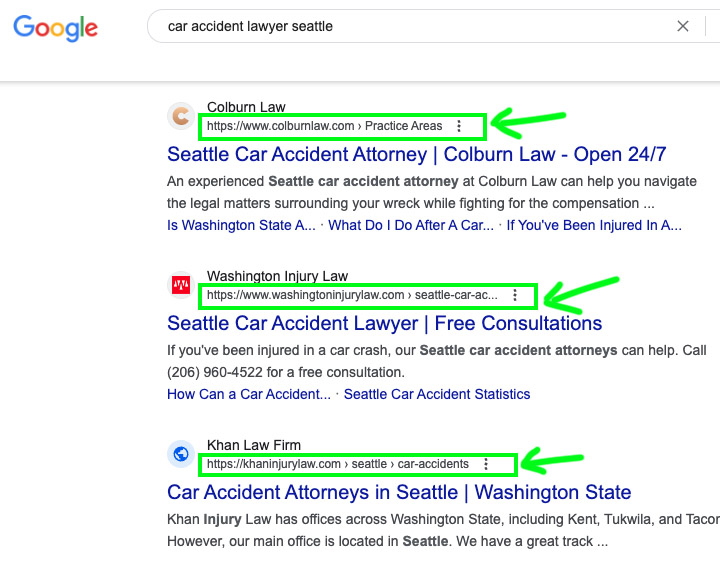
Actionable Steps for Website Structure:
- Structure Case-Specific Pages: Build out separate pages on your website for each type of personal injury case you handle, such as car accidents and medical malpractice, detailing the nuances and legal insights pertinent to each.
- Localize Case-Specific Pages: Create individual pages for each geographic area you serve, tailored to the local audience with content that addresses their specific concerns and legal scenarios.
- Ensure Content Quality: Fill these pages with high-quality, informative content that not only answers common questions but also addresses specific local needs, reinforcing your expertise and relevance for each case type and geographic area.
Key Element 2: Content Strategy and Building Topical Authority
A solid content strategy is key for personal injury lawyers aiming for SEO success. It’s not just about being found on search engines; it’s about being seen as a go-to source for personal injury law in your area.
Creating content is one of two key elements that will produce 80%+ of SEO results
Key Aspects of a Successful Content Strategy
-
- Align with Search Intent: Understand what your prospective clients are looking for and tailor your content to answer their questions and address their common concerns. This makes your site a valuable resource, which search engines love.
- Consistent Traffic & Engagement: Keep adding fresh, relevant content. It keeps visitors coming back, and search engines take notice, improving your rankings.
- Building Topical Authority: Establish yourself as an expert by focusing on personal injury law topics.
Importance of Developing Topical Authority
Topical authority means being a specialist in your field online. It’s crucial for SEO because Google prefers sites that show deep, authoritative knowledge in a specific area.
Furthermore, our own survey found that your prospective clients are looking for attorneys who “specialize” in their needed area of law, making topical authority extremely important for not only ranking well in search engines, but also for converting prospective clients after they’ve found your website.
Survey Question 4: What factors would be most important to you when deciding on which attorney to hire (rank in order of importance, 1 being the most important and 5 being the least important)

Benefits of Topical Authority
-
- Relevance and Accuracy: More in-depth content on personal injury law means Google sees your site as a more relevant result for your target keywords.
- Expertise and Trustworthiness: Showcasing extensive knowledge builds trust – with both Google and potential clients.
- User Satisfaction and Engagement: Covering various aspects of personal injury law keeps users interested and on your site longer, which Google rewards.
- Keyword Coverage and Context: More content equals more chances to include relevant keywords, helping Google understand and rank your site better.
- Backlink Potential: Quality content attracts links from other reputable sites, a critical element of SEO success.
Focus on Quality over Quantity
The quality of your content matters more than quantity. Google can tell if you’re just churning out pages without much value. Focus on well-researched, engaging content. Less high-quality content is preferable to a lot of low-quality pages and blog posts.
Creating a Content Strategy for Topical Authority
Leverage tools like Google Search Console, Ahrefs, and Moz for insights into keywords and what your competition is doing. This data, combined with an understanding of your target audience will shape a strategy that resonates with potential clients and boosts your SEO efforts.
Bonus Tip: Leveraging Video Content for SEO
 Video content is an extremely under tapped SEO resource. Video content can play a significant role in boosting key metrics considered by Google for search engine rankings. Among these metrics, the duration users spend on your website and the quantity of backlinks to your domain are paramount for SEO success.
Video content is an extremely under tapped SEO resource. Video content can play a significant role in boosting key metrics considered by Google for search engine rankings. Among these metrics, the duration users spend on your website and the quantity of backlinks to your domain are paramount for SEO success.
Incorporating video typically enhances both these aspects. Research indicates that pages with videos hold visitors’ attention more than twice as long as those without. Additionally, high-quality video content increases the likelihood of earning backlinks.
Therefore, video contributes to SEO in a twofold manner. It not only has a potential direct impact on your rankings but also positively affects other critical factors considered in Google’s ranking algorithm.
Furthermore, for personal injury attorneys, high quality videos can enhance your brand appeal to prospective clients while also introducing yourself to them, making your firm feel more approachable. Both factors can go a long way in increasing your conversion rates.
Actionable Steps for Content Strategy:
- Develop a Content Roadmap: Create a list of keyword focused topics around information that your potential clients would find useful and valuable. This will be the roadmap for your content strategy. Use tools like Google Search Console, Ahrefs, and questions found under “People Also Ask” on Google to find useful keywords and topics to include in your roadmap.
- Publish Regularly: Publish a consistent flow of high-quality, well-researched articles and videos that answer your prospective clients’ biggest questions and concerns.
- Bonus Step – Create YouTube Videos: To capitalize on video content for SEO, integrate videos on your site to increase visitor engagement time and encourage backlinks, thus improving Google ranking factors.
Key Element 3: On-Page Optimization
In SEO, on-page optimization refers to the practice of optimizing the elements on your website’s individual pages to improve their ranking in search engine results pages (SERPs).
On-page elements are critical for SEO as they help search engines understand and rank your content. These include titles, headings, meta descriptions, and the content itself. Each element plays a specific role: titles attract attention in search results, meta descriptions provide a brief overview enticing users to click, and headings structure your content for easy readability.
Effective use of on-page SEO not only boosts your site’s visibility but also enhances the user experience, increasing the likelihood of turning website visitors into clients.
Elements of On-Page SEO
-
- Title Tags and Meta Descriptions: Craft title tags that are both keyword-rich and compelling to encourage clicks. Meta descriptions should offer a concise preview of the page’s content, utilizing call-to-action language where appropriate to drive engagement.
- Header Tags: Use header tags (H1, H2, H3, etc.) to structure your content logically. Your H1 should include your primary keyword and draw the reader in, while subsequent headers help organize content into digestible sections, integrating secondary keywords.
- Internal Linking: Develop a web of internal links that help users navigate your content easily. Linking to relevant articles and service pages can enhance user engagement and time on site, both positive signals to search engines.
- Image Optimization: Images enhance user experience, but they must be optimized for SEO. This means using descriptive file names, adding alt text with keywords, and compressing images to improve page load speeds.
- Content Structure: Ensure your content is easy to read, with short paragraphs, bullet points, and multimedia elements like images and videos to break up text. This helps retain user attention and reduce bounce rates.

By focusing on these on-page factors, personal injury lawyers can create a website that not only appeals to potential clients but also satisfies search engine algorithms, leading to better rankings and more traffic.
Actionable Steps for On-Page Optimization:
- Optimize Titles and Descriptions: Review and refine your website’s titles and meta descriptions to ensure they are engaging and include relevant keywords.
- Structure with Purpose: Go through your headers to confirm they provide a clear guide through your content and incorporate appropriate keywords.
- Enhance Internal Navigation: Check your internal links for clarity and ease of navigation, ensuring they create a logical path for users and search engines.
- Improve Content Layout: Your website content should not be solid walls of text. The pages should be laid out in a way that is easy for your website visitors to read and particularly to scan.
Key Element 4: Backlinks
A backlink is simply a link on one website that points to another website. Imagine it like a citation in an academic paper: when one website links to another, it’s essentially saying “this source is relevant and worth checking out.”
Backlinks are pivotal for SEO success as they serve as trust signals to search engines like Google. A site with a robust portfolio of backlinks is typically viewed as more authoritative, which is a key factor in search engine algorithms. Prioritizing backlinks can give you an edge over your competitors, driving more potential clients to your website.
Building backlinks is one of two key elements that will produce 80%+ of SEO results.
Assessment of Backlink Needs
Understanding what you’re up against is essential to creating an SEO budget and focusing your efforts. By analyzing the backlinks of the top-ranking law firms in your geographic service area, you can gauge the approximate number of backlinks you’ll need to get your website to rank on the first page of search engine results. And while more backlinks won’t automatically move you ahead of a competitor, there is a very strong correlation.
You can utilize SEO tools such as Ahrefs to assess your competitor’s backlink profiles. This strategic approach will help you allocate your SEO budget more effectively.
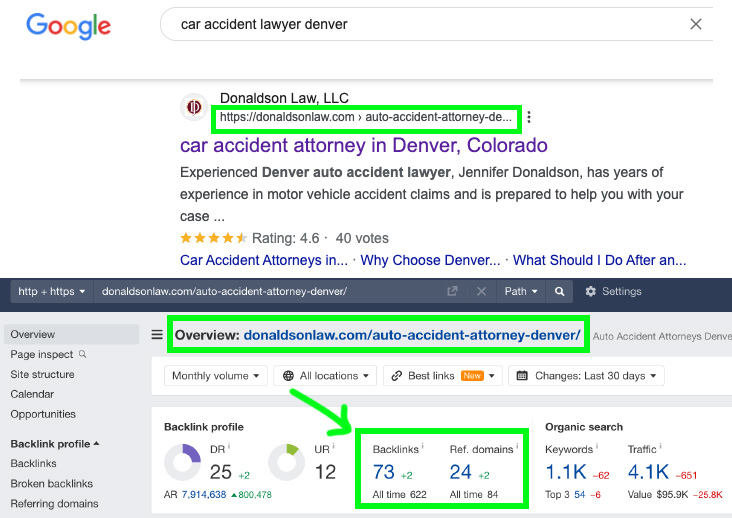
Quality Over Quantity
High-quality links from reputable, high-authority sites such as prominent news sites (think Forbes, Bloomberg, Reuters, and local news stations), educational institutions, and legal publications can elevate your site’s status more than numerous low-quality links. They tell search engines that your site is a trusted resource, thus helping to increase your visibility in search results.
Investing in activities that attract these types of backlinks such as content creation and digital PR is a wise use of resources, as these backlinks yield significantly better results.
Diversity in Backlink Profiles
Diversifying your backlink profile is akin to diversifying an investment portfolio—it spreads risk and increases the potential for reward. A diverse backlink profile indicates a natural and healthy link ecosystem to search engines, improving your site’s trust and authority.
When possible, backlinks should be pointed to your targeted landing pages and not just your homepage. This can help enhance the authority of the pages you are wanting to rank.
This strategy improves the overall strength of your site and can lead to multiple pages ranking for their respective keywords.
Types of Backlinks: Citation vs. Editorial
There are two main types of backlinks, each serving a different purpose:
-
- Citation Backlinks: Think of these as listings in a digital phone book. They can be easily acquired by registering with legal directories, which can also help potential clients find your firm.
- Editorial Backlinks: These are the highest value backlinks. Acquired by producing good content that others want to share, they solidify your website’s reputation for quality information. They require more effort to acquire, but can significantly bolster your authority and search engine rankings.
Backlink Anchor Text and SEO
Anchor text—the clickable text in a hyperlink—is also an important part of your backlink profile. It should be relevant and keyword-rich, providing search engines with context about the content of the linked page. Properly optimized anchor text can enhance your site’s relevance for specific keyword search terms, which can translate to higher rankings and more targeted traffic.
Practical Ways to Aquire Backlinks
There are several strategies for attorneys and law firms to obtain backlinks:
-
- Legal Directories: Being listed on websites like Avvo, Justia, and Lawyers.com can yield citation backlinks.
- Guest Blogging: Writing articles for other sites can result in valuable editorial backlinks.
- Link Magnets: Informative blog posts, infographics, surveys, and e-books naturally attract backlinks and can establish your firm as a thought leader.
- Local Organizations and Partnerships: Getting links through your local network like the Chamber of Commerce, or vendors and referral partners such as a local chiropractor.
Actionable Steps for Backlinks:
- Analyze Competitor Backlink Profiles: Investigate and understand the backlink profiles of top-ranking competitors using SEO tools like Ahrefs. This will show you the gap your firm needs to bridge in terms of quality and quantity of backlinks.
- Prioritize High-Quality Backlinks: Quality backlinks from authoritative domains are more influential and provide a stronger signal to search engines about the credibility of your website than a larger number of low-quality links.
- Diversify Your Approach: Don’t just point backlinks to your homepage. Expand your backlink profile to include a mix of homepage links, but also (very importantly) backlinks to your targeted landing pages. Also, diversify they types of backlinks you build, such as both citation and editorial.
- Know What You’re Paying For. If you are working with or considering hiring an agency to do SEO work for you, pay particular attention to their backlink strategy. Keep track of how many backlinks they are acquiring and to what pages. This is one of the most important elements to improving rankings in search engines. Make sure your SEO budget is being focused here.
Key Element 5: Google Maps and Local SEO
A solid organic SEO strategy is the foundation upon which your Google Maps visibility is built. By optimizing your website content for search engines, you not only improve your position in traditional search results but also enhance your visibility in local Maps listings.
This is essential because when your firm ranks highly on search engine results pages (SERPs), it signals to Google that your website is a credible source of information, which translates to higher Google Maps rankings. Conversely, a prominent position in Google Maps can boost your organic search presence by confirming your physical location’s legitimacy and relevance to local searchers.
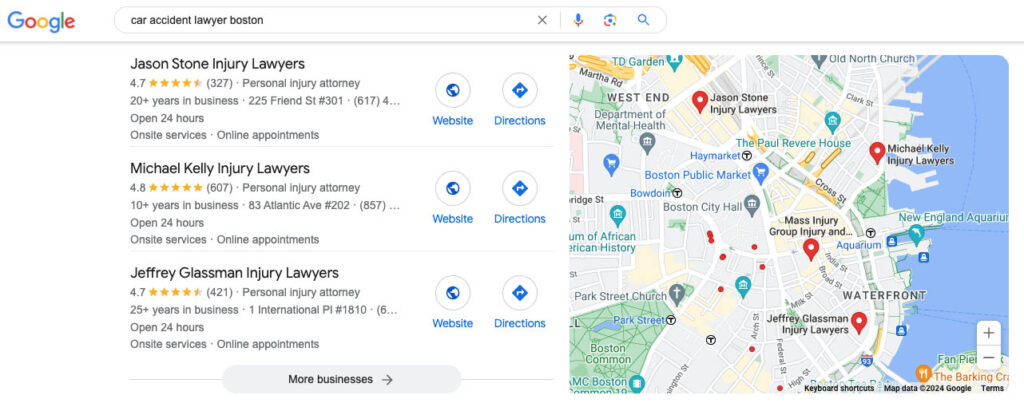
Boosting Local SEO with Client Reviews
Positive reviews on your Google Business listing not only enhances your firm’s credibility but also signals to Google the trustworthiness of your services leading to improved Maps rankings.
Actively managing your online reputation by gathering positive reviews can lead to a cycle of increased visibility and more clients. It’s one of the biggest quick wins in personal injury digital marketing.
The Power of Local Backlinks in Google Maps Rankings
As mentioned in Key Element 4 above, backlinks from local sources such as directories, community sites, or local news outlets act as local SEO enhancers. They help establish your firm’s presence within a specific geographical area, which is important for high Google Maps rankings.
Using Tools to Monitor Your Google Maps Rankings
Tools like BrightLocal and LocalFalcon offer invaluable insights into your Google Maps performance, allowing you to fine-tune your strategy based on real data. By understanding where you rank in different parts of your target city or region, you can allocate your SEO resources more effectively, ensuring that you’re not just competing, but leading in local search rankings.
![]()
![]()
Actionable Steps for Google Maps and Local SEO:
- Claim and Verify Your Google Business Listing: Ensure your Google Business profile is claimed, verified, and contains accurate and up-to-date information.
- Solicit and Respond to Reviews: Actively encourage satisfied clients to leave positive reviews on your Google Business listing and make sure to respond to these reviews to show engagement.
- Ensure NAP Consistency: Using tools such as BrightLocal or Moz, check that your firm’s Name, Address, and Phone number (NAP) are consistent across all online directories and listings to strengthen local SEO signals.
- Develop Localized Content: Create content that targets the specific geographic areas you serve, using local keywords and references to enhance relevance in local search results.
- Monitor Local Rankings: Use tools like BrightLocal or LocalFalcon to track your Google Maps rankings and identify areas for improvement in your local SEO strategy.
Tracking SEO Success and Measuring ROI for Personal Injury Law Firms
Key Metrics for Tracking SEO Progress
To ensure your SEO efforts are paying off, focus on these three essential metrics:
- Keyword Rankings: Use tools such as Ahrefs or Semrush to monitor the positions of your targeted keywords in search engine results to gauge if your SEO campaign is moving in the right direction.
- Website Traffic: Use tools such as Google Analytics and Google Search Console to track the volume of visitors coming to your site from search engines, indicating the reach and impact of your SEO.
- Conversions: To truly know the effectiveness of your SEO campaign and to measure your ROI, you must tracking conversions. These include phone calls and contact form submissions from visitors who found you via search engines.
![]()
Free Conversion Tracking with Google Analytics: Google Analytics is invaluable for measuring SEO campaign effectiveness. It provides insights into website traffic sources and can also track conversions.
![]()
Paid Conversion Tracking Tools: For more detailed tracking (particularly for phone call conversions) consider integrating tools such as CallRail or WhatConverts with Google Analytics. This setup will give you a clearer picture of how your SEO efforts translate into actual leads and ultimately new clients and cases.
By focusing on these key metrics and using the right tools, you can not only track the success of your SEO campaign but also measure the ROI effectively.
This will ensure that your investment in SEO aligns with your firm’s goal of acquiring new clients and growing revenue. It can also empower you to make more informed, data driven decisions when it comes to allocating your marketing budget.
Actionable Steps for Tracking SEO Progress and Measuring ROI:
- Monitor Key Metrics: Use SEO tools such as Ahrefs or Semrush to monitor and track keyword rankings. Also, analyze your website traffic sources and volume in Google Analytics.
- Set Up Conversion Tracking: Create “Conversions” in Google Analytics to track conversions from phone calls and contact forms. For detailed call tracking, integrate services like CallRail or WhatConverts.
- Review and Adjust: Regularly review keyword and conversion data. Refine SEO tactics based on performance insights to boost ROI.
The Cost of SEO Services for Personal Injury Lawyers and Creating a Budget
Price Range for SEO Services
For personal injury attorneys, SEO service costs can vary widely. While some providers offer reasonable rates, others may charge exorbitantly high fees. I know of agencies charging as little as $500 per month, while others are charging $10,000+. It’s important to understand that a higher price doesn’t always equate to better results. But what it should equate to at a minimum is more resources.
To effectively move the needle (meaning to significantly impact your online visibility and client acquisition) your spending should ensure the delivery of essential SEO elements, specifically content and backlinks.
In my opinion, the entry price for effective SEO services for personal injury lawyers starts around $1,500 per month.
This amount will vary depending on the geographic market and overall competition, but in general is enough for us to effectively target one specific keyword group (i.e. car accident lawyer, slip and fall lawyer, wrongful death attorney, etc.) in one geographic area.
By increasing your budget, you increase the resources available to go after more keyword groups and in more geographic service areas. You can also influence the speed at which you see results based on your budget. The more quality content that is created for your website, and the more high-value backlinks you obtain, in most instances will produce results more quickly.
One thing to always keep in mind, is there are never any guarantees when it comes to SEO. Each individual keyword and geographic market is different with varying levels of competition, this can yield different results over different timelines.
But, if substantial progress isn’t observed within 3-6 months, it’s probably time to reevaluate the strategy being employed by your SEO provider.
Contracts and Commitments
Many SEO service providers require a 12-month contract, but caution is advised when committing to long-term agreements. While some agencies legitimately require contracts due to the initial heavy lifting associated with SEO work, others may use them to lock in clients without having to worry about producing results.
These agencies are in the sales business, not the SEO business (and unfortunately there are many of them). When considering an SEO agency to work with, be sure to thoroughly vet their approach and reputation before committing. This will help to ensure they are in the business of delivering results, not just making sales.
Our recommendation is to opt for SEO services that don’t require long-term contracts, providing you with the flexibility to assess the effectiveness and ROI from the outset.
Furthermore, by combining SEO with a PPC (Google Ads) strategy, some agencies (such as ours), aim to start delivering new clients quickly. An approach such as this can potentially cover the cost of SEO services from day one. The idea being to produce immediate ROI while the long-term benefits of SEO build over time.
Conclusion: Capitalizing on the Opportunity SEO Offers to Personal Injury Lawyers
Your path to more clients and higher revenue via Search Engine Optimization is now clear. This guide has cut through the noise of SEO and turned it into actionable insights for you. You now understand that focusing on just two key elements (content and backlinks) will yield over 80% of your results.
A successful SEO campaign is not about outspending your competition; it’s about making smarter, data-driven decisions that maximize your budget and results.
With a very realistic budget, SEO can deliver one of the highest returns of any marketing activity for your firm. And remember, effective SEO is scalable — as your firm grows, your SEO strategy can expand to capture broader audiences and more specific keyword groups. It doesn’t have to be an “all or nothing” approach.
The tools and strategies covered here are not just theoretical; we’ve used them time and again to produce page 1 rankings for our own clients. They’re your guide to improved search rankings, increased leads, and measurable growth for your personal injury law firm. Use this knowledge to focus on what truly moves the needle and watch as your firm rises in the search engine rankings.
The time to act is now. For a detailed strategy that fits your firm’s unique needs, schedule an SEO strategy session with us today. Let us put these principles to work for you to increase your firm’s revenue so that you can grow it at the pace that you want.
About the Author
Chris is a legal marketing consultant who has been helping attorneys and law firms grow their revenue and scale their legal practices for the past 13 years. His areas of expertise are in content marketing, search engine optimization (SEO), pay-per-click (PPC), digital PR & branding, and conversion rate optimization (CRO).
More Personal Injury Marketing Tips & Insights

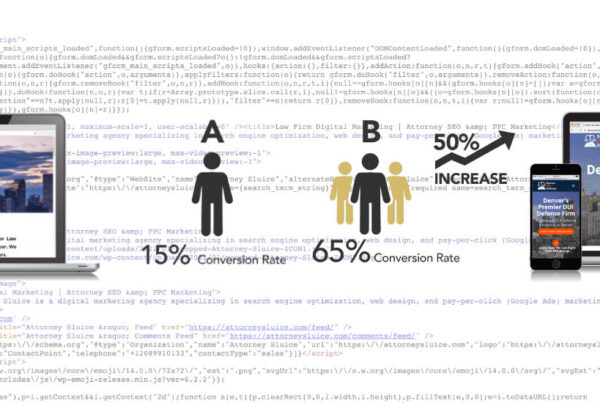
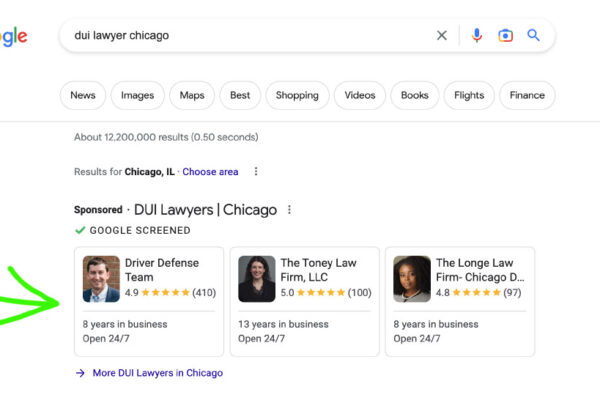
Ready to Start Growing Your Personal Injury Law Firm?
Schedule a FREE Strategy Session
What your strategy session will be focused on:
- In-Depth Digital Presence Analysis: Discover how your current online footprint measures up and how to enhance it.
- Competitor Analysis: Uncover what your competitors are doing and how to outperform them.
- Branding & Conversions Analysis: Understand how to not just attract traffic, but convert it into paying clients.
- Expert Second Opinion: Get a fresh perspective on your current marketing strategies and their effectiveness.
- Comprehensive Q&A: Receive personalized answers to your questions, offering clarity and strategic direction for your law firm’s digital marketing efforts.



